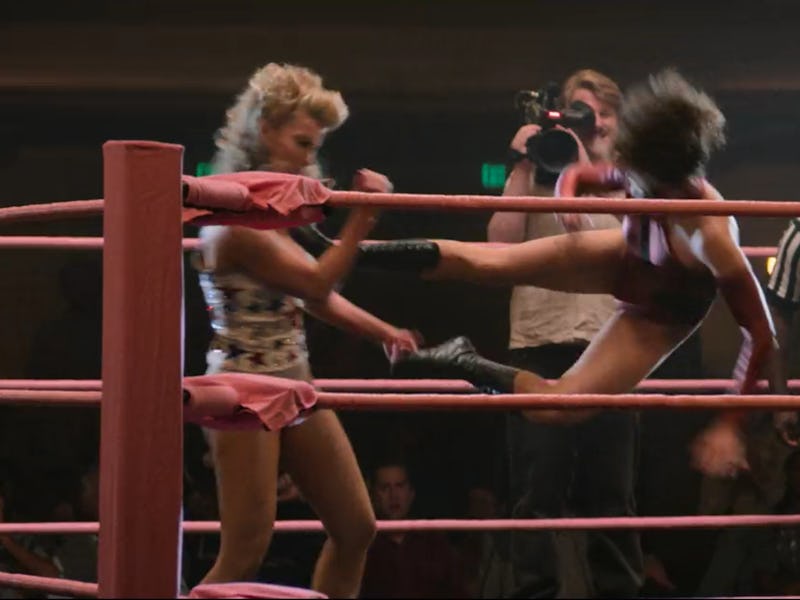The “sleeper hold,” “forward roll,” and “diving cross body’ are just some of the moves you’ll see in the new Netflix series GLOW. The series, a fictionalized history of the 1980s cable show Gorgeous Ladies of Wrestling, pulls out all the stops when it comes to depicting the actresses’ physical suffering. The first season’s ten episodes are filled with epic arm twists and body slams that are guaranteed to make you flinch with sympathy pain.
Caution: Mild spoilers for GLOW ahead.
While none of the actresses in the Netflix show got seriously injured, the original cast of the all-women’s wrestling show sure did. In the documentary GLOW: The Story of the Gorgeous Ladies of Wrestling, the original cast talks about rotator cuff tears, torn menisci, ripped ACLs, and broken elbows. But there’s a greater danger hidden behind all of those injuries, physical therapist and former college wrestler Patrick Vignona tells Inverse — one that doesn’t exactly heal.
Liberty Belle finishes Zoya the Destroya off with a diving crossbody.
Vignona, who works with all types of athletes at the Sports Rehabilitation Center at the Hospital for Special Surgery in New York City, explains that the risks of professional wrestling are similar to those in other high-velocity sports like hockey and football. “Any football injury you see, any injury you see in professional sports, period, 100% [wrestlers] are at a very high chance of doing that,” said Vignona. Crucially, he points out, those risks also include traumatic brain injury.
The Welfare Queen about to slam Liberty Belle to the ground with a Samoan drop.
Examining videos of the diving crossbody that Liberty Belle and Zoya the Destroya work on and the Samoan drop that the Welfare Queen uses, Vignona says, “I can see a concussion happening from every single one of those moves.”
The dangerous part isn’t actually getting hit, he explains; it’s the rapid acceleration and deceleration that happens when a move is performed. This sudden change in speed can cause the brain to rattle inside the skull, which is what leads to a concussion. Repeated concussions can lead to serious neurological that affect a person’s vision, hearing, motor skills and cognitive skills.
The sleeper hold is a less dangerous and easy-to-fake move.
Wrestlers try to decrease the risks of their craft by developing tricks, like tucking in their chins before hitting the ground, but these efforts have a limited effect. There is no risk-free way of doing these moves, says Vignona: “Coordinated or not coordinated, they’re still taking a huge hit.” Even practicing the moves are dangerous, especially if they are done wrong. Repeated attempts, after all, can cause injury by overworking the muscles.
The hammer lock looks painful but can easily be fake during a wrestling match.
Vignona argues that all wrestling moves are risky, but he admits that some moves pose less of a danger than others. Moves like the sleeper hold, bronco buster, and hammer lock are easier to control or fake, he says. But for the women of G.L.O.W., whether in real life or on Netflix, there is only so much that can be faked.
“There is no way to fight without really fighting, said Eileen O’Hara, an original member of G.L.O.W., in the documentary GLOW: The Story of the Gorgeous Ladies of Wrestling. “I’ve never found out how to do that. We had to connect. We had audiences on four sides. If you didn’t connect, they would start chanting ‘bullshit’.”
